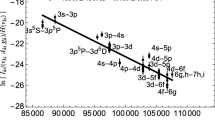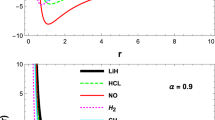Abstract
The dissociation of a gas molecule and the formation of a new chemical bond upon adsorption of this molecule on the surface of a transition metal are studied using the method of equations of motion. It is shown that both processes involve the formation of a mixed intermediate state during the adsorbate-substrate interaction. The dissociation is caused by a resonance growth of the vibrational mode, whereby the dissociation barrier is determined by the hybridization energy and by the frequency of electron transitions between molecular levels and the d electron energy levels of the metal in the mixed intermediate state. The resonance conditions for the formation of new surface structures are established.
Similar content being viewed by others
References
G. J. Kroes, A. Gross, E. J. Baerends, et al., Acc. Chem. Res. 35, 193 (2002).
B. Hammer and J. K. Norskov, Surf. Sci. 343, 211 (1995).
Wei-Xue Li, C. Stampfl, and M. Scheffler, Phys. Rev. B 65, 075 407 (2002).
J. Greeley, J. K. Norskov, and M. Mavrikakis, Annu. Rev. Phys. Chem. 53, 319 (2002).
C. Stampfl, M. V. Granduglia-Pirovano, K. Reuter, and M. Scheffler, Surf. Sci. 500, 368 (2002).
S. F. Borisov, N. F. Balakhonov, and V. A. Gubanov, Interaction of Gases with Solid Surfaces (Nauka, Moscow, 1988) [in Russian].
V. P. Vereshchagin and M. P. Kashchenko, Teor. Mat. Fiz. 42, 133 (1980).
A. V. Vedyaev, V. E. Egorushkin, and N. V. Mel’nikova, Teor. Mat. Fiz. 71, 259 (1988).
V. E. Egorushkin and N. V. Mel’nikova, Zh. Éksp. Teor. Fiz. 103, 189 (1993) [JETP 76, 103 (1993)].
V. E. Egorushkin and N. V. Mel’nikova, Zh. Éksp. Teor. Fiz. 103, 214 (1993) [JETP 76, 280 (1993)].
V. I. Iveronova and A. A. Katsnel’son, Short-Range Order in Solid Solutions (Nauka, Moscow, 1977) [in Russian].
E. M. Lifshitz and L. P. Pitaevskii, Physical Kinetics (Nauka, Moscow, 1979; Pergamon, Oxford, 1981).
P. Blaha, K. Schwarz, G. K. M. Madsen, et al., in Proceedings of WIEN2k (Vienna University of Technology, Vienna, 2001), ISBN 3-9501031-1-2.
Author information
Authors and Affiliations
Additional information
__________
Translated from Zhurnal Éksperimental’no\(\overset{\lower0.5em\hbox{$\smash{\scriptscriptstyle\smile}$}}{l} \) i Teoretichesko\(\overset{\lower0.5em\hbox{$\smash{\scriptscriptstyle\smile}$}}{l} \) Fiziki, Vol. 128, No. 2, 2005, pp. 403–410.
Original Russian Text Copyright © 2005 by Egorushkin, Kul’kova, Mel’nikova, Ponomarev.
Rights and permissions
About this article
Cite this article
Egorushkin, V.E., Kul’kova, S.E., Mel’nikova, N.V. et al. To the quantum theory of chemical activity of the surface of transition metals. J. Exp. Theor. Phys. 101, 350–356 (2005). https://doi.org/10.1134/1.2047801
Received:
Issue Date:
DOI: https://doi.org/10.1134/1.2047801




